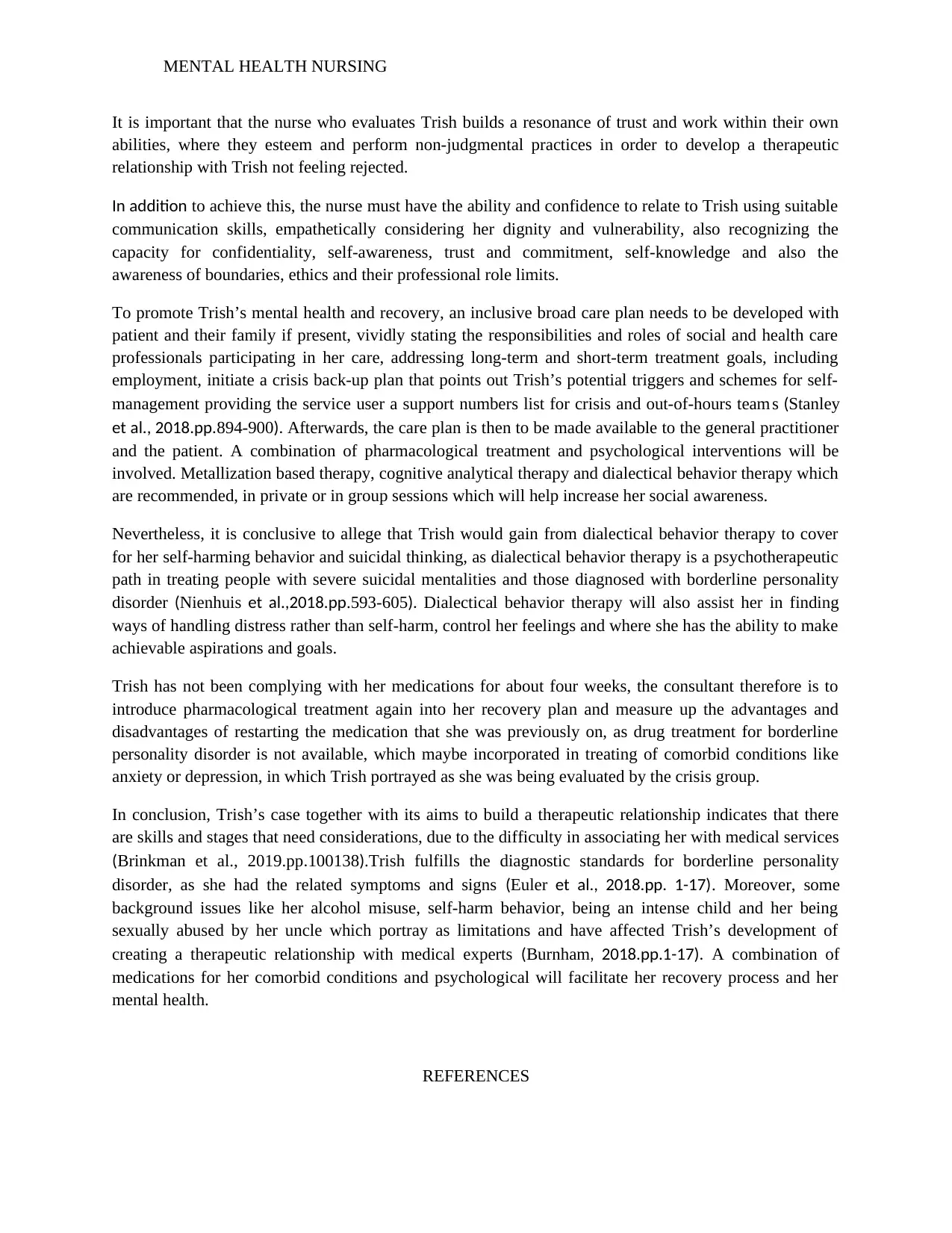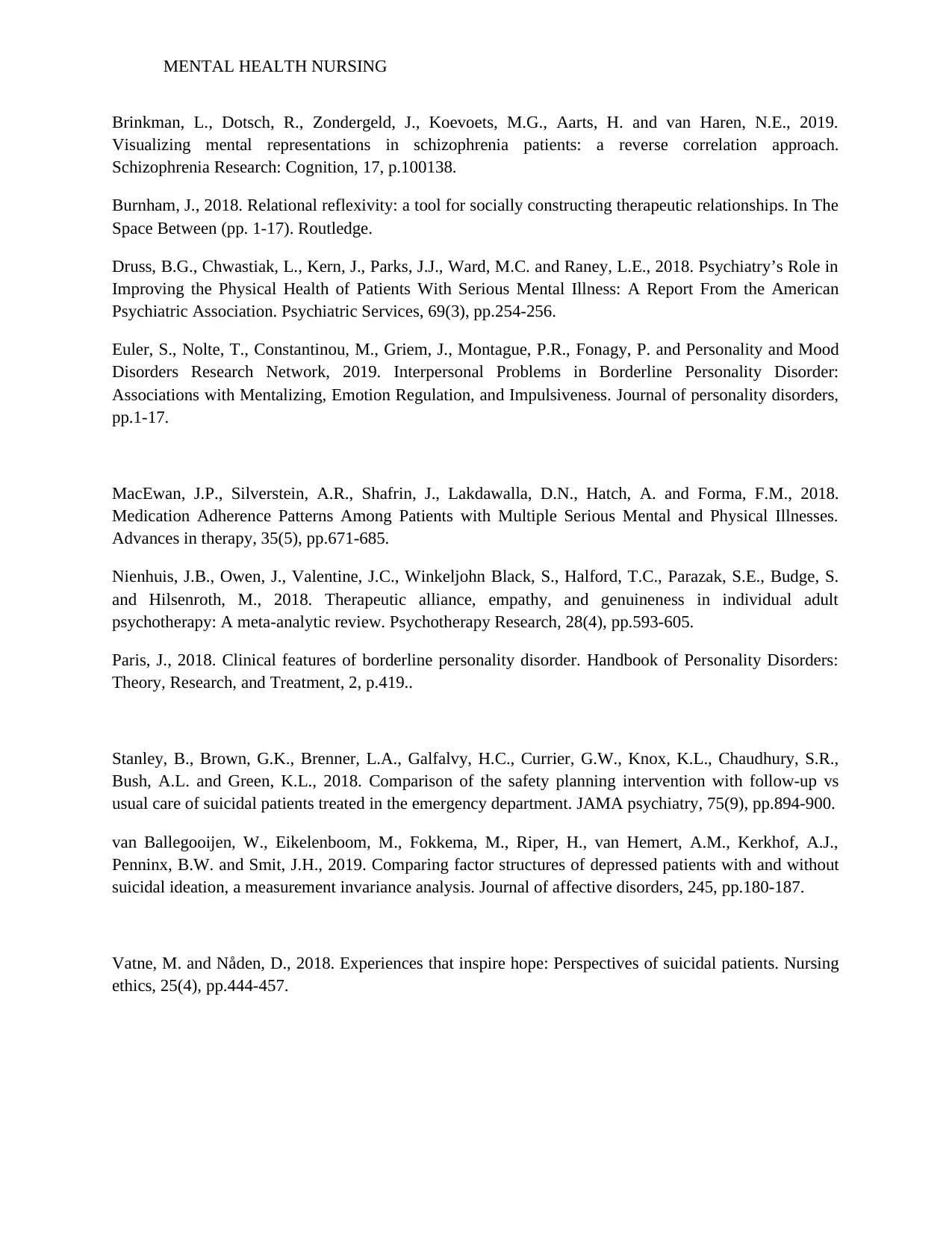Mental Health Nursing: Trish's Case Study and Recovery Promotion
VerifiedAdded on 2023/01/19
|4
|1662
|100
Essay
AI Summary
This essay delves into the complexities of mental health nursing, specifically addressing the case of Trish, a 28-year-old woman with a history of mental health challenges, including a potential diagnosis of borderline personality disorder. The essay emphasizes the critical importance of establishing and maintaining a therapeutic relationship with Trish, highlighting the necessary skills and stages involved, such as building trust, empathy, and non-judgmental practices. It outlines a comprehensive care plan that incorporates both pharmacological treatments and psychological interventions, including Dialectical Behavior Therapy (DBT) to address self-harming behaviors and suicidal ideation. The essay also explores the impact of Trish's past traumas and substance misuse on her mental health and recovery, underscoring the need for a holistic and individualized approach to treatment, incorporating the patient's family if present, and providing access to crisis support. Ultimately, the essay demonstrates the multifaceted nature of mental health care and the importance of a strong therapeutic alliance in promoting positive outcomes for individuals like Trish.

MENTAL HEALTH NURSING
MENTAL HEALTH NURSING
STUDENT NAME
COURSE NAME
UNIVERSITY AFFILIATED
MENTAL HEALTH NURSING
STUDENT NAME
COURSE NAME
UNIVERSITY AFFILIATED
Paraphrase This Document
Need a fresh take? Get an instant paraphrase of this document with our AI Paraphraser

MENTAL HEALTH NURSING
INTRODUCTION
This essay is aimed at demonstrating how to found and maintain a therapeutic relationship with Trish, a
twenty eight year old single British woman and help her be affiliated to the services intended to produce
purposeful progress in her recovery (MacEwan et al., 2018.p.671-685).
. Trish is well-known to health services based on her past experiences with an indicated diagnosis of
personality disorder. I will shortly analyze the cause, symptoms and signs that she is exhibiting, which
will then explain what she is suffering from, as well as clearly show how to manage Trish’s mental health
and recovery options.
There are various personality disorders, which explain individuals’ feelings, behavior and form of thought
(van Ballegooijen et al., 2019.pp.180-187). Trish’s behavior and symptoms, indicate and also establish
her susceptibility to a medical condition known as borderline personality disorder, which qualifies as per
the standards in the disease international classification and which are types of personality disorders and
refer similar mental health condition. Nevertheless, Trish’s condition is referred to as borderline
personality disorder.
Vatne & Nåden (2018.pp.444-457),outline the characteristics of borderline personality disorder, whereby
the individual’s mood is unpredictable, impulsive acting, problems having a long-term relationship, lack
of control of their behavior and outburst of emotion. There is the borderline type which is characterized
by feelings of emptiness, self-image, involved in many unstable relationships, suicidal ideation and self-
harm and the other one is the impulsive type which is characterized predominantly via emotional
instability
Trish’s condition seems to be complicated as there are characteristics of post-traumatic stress of her
uncle’s sexual abuse, alcohol misuse and depression, her being an intense child and emotional
withdrawal; making it clear of tributary factors to the cause of her disorder. There is no individual cause,
but combined factors like environmental and biological factors make the person vulnerable, and where
some individuals have experienced and developed difficulties in the course of their upbringing.
Before meeting up with Trish, it is vital to have valid information regarding her social and personal
history besides what she has been presented with and her condition (Druss et al., 2018.pp.254-256). To
build a therapeutic relationship, the following need considerations; knowledge of the person, background
knowledge, knowledge of the disease, knowledge of the contributing diverse influences and also the
development and interpersonal theory.
Trish’s therapeutic relationship with the nurse is important, in terms of interacting with and towards her
goals set out to assist her in learning a better way of dealing with her emotions, behavior and thought
which will hopefully lead to beneficial change, as individuals have the ability to influence positive health
results.
According to Paris (2018.p.419), considerations of the three therapeutic relationship phases need to be
done; first is the orientation phase whereby the service user and the nurse familiarize with each other so
as to build trust, then secondly, the working phase whereby the service user describe their problems that
need working on and finally, the resolution phase which is the process of weaning off so that the service
user can recommence freedom.
INTRODUCTION
This essay is aimed at demonstrating how to found and maintain a therapeutic relationship with Trish, a
twenty eight year old single British woman and help her be affiliated to the services intended to produce
purposeful progress in her recovery (MacEwan et al., 2018.p.671-685).
. Trish is well-known to health services based on her past experiences with an indicated diagnosis of
personality disorder. I will shortly analyze the cause, symptoms and signs that she is exhibiting, which
will then explain what she is suffering from, as well as clearly show how to manage Trish’s mental health
and recovery options.
There are various personality disorders, which explain individuals’ feelings, behavior and form of thought
(van Ballegooijen et al., 2019.pp.180-187). Trish’s behavior and symptoms, indicate and also establish
her susceptibility to a medical condition known as borderline personality disorder, which qualifies as per
the standards in the disease international classification and which are types of personality disorders and
refer similar mental health condition. Nevertheless, Trish’s condition is referred to as borderline
personality disorder.
Vatne & Nåden (2018.pp.444-457),outline the characteristics of borderline personality disorder, whereby
the individual’s mood is unpredictable, impulsive acting, problems having a long-term relationship, lack
of control of their behavior and outburst of emotion. There is the borderline type which is characterized
by feelings of emptiness, self-image, involved in many unstable relationships, suicidal ideation and self-
harm and the other one is the impulsive type which is characterized predominantly via emotional
instability
Trish’s condition seems to be complicated as there are characteristics of post-traumatic stress of her
uncle’s sexual abuse, alcohol misuse and depression, her being an intense child and emotional
withdrawal; making it clear of tributary factors to the cause of her disorder. There is no individual cause,
but combined factors like environmental and biological factors make the person vulnerable, and where
some individuals have experienced and developed difficulties in the course of their upbringing.
Before meeting up with Trish, it is vital to have valid information regarding her social and personal
history besides what she has been presented with and her condition (Druss et al., 2018.pp.254-256). To
build a therapeutic relationship, the following need considerations; knowledge of the person, background
knowledge, knowledge of the disease, knowledge of the contributing diverse influences and also the
development and interpersonal theory.
Trish’s therapeutic relationship with the nurse is important, in terms of interacting with and towards her
goals set out to assist her in learning a better way of dealing with her emotions, behavior and thought
which will hopefully lead to beneficial change, as individuals have the ability to influence positive health
results.
According to Paris (2018.p.419), considerations of the three therapeutic relationship phases need to be
done; first is the orientation phase whereby the service user and the nurse familiarize with each other so
as to build trust, then secondly, the working phase whereby the service user describe their problems that
need working on and finally, the resolution phase which is the process of weaning off so that the service
user can recommence freedom.

MENTAL HEALTH NURSING
It is important that the nurse who evaluates Trish builds a resonance of trust and work within their own
abilities, where they esteem and perform non-judgmental practices in order to develop a therapeutic
relationship with Trish not feeling rejected.
In addition to achieve this, the nurse must have the ability and confidence to relate to Trish using suitable
communication skills, empathetically considering her dignity and vulnerability, also recognizing the
capacity for confidentiality, self-awareness, trust and commitment, self-knowledge and also the
awareness of boundaries, ethics and their professional role limits.
To promote Trish’s mental health and recovery, an inclusive broad care plan needs to be developed with
patient and their family if present, vividly stating the responsibilities and roles of social and health care
professionals participating in her care, addressing long-term and short-term treatment goals, including
employment, initiate a crisis back-up plan that points out Trish’s potential triggers and schemes for self-
management providing the service user a support numbers list for crisis and out-of-hours team s (Stanley
et al., 2018.pp.894-900). Afterwards, the care plan is then to be made available to the general practitioner
and the patient. A combination of pharmacological treatment and psychological interventions will be
involved. Metallization based therapy, cognitive analytical therapy and dialectical behavior therapy which
are recommended, in private or in group sessions which will help increase her social awareness.
Nevertheless, it is conclusive to allege that Trish would gain from dialectical behavior therapy to cover
for her self-harming behavior and suicidal thinking, as dialectical behavior therapy is a psychotherapeutic
path in treating people with severe suicidal mentalities and those diagnosed with borderline personality
disorder (Nienhuis et al.,2018.pp.593-605). Dialectical behavior therapy will also assist her in finding
ways of handling distress rather than self-harm, control her feelings and where she has the ability to make
achievable aspirations and goals.
Trish has not been complying with her medications for about four weeks, the consultant therefore is to
introduce pharmacological treatment again into her recovery plan and measure up the advantages and
disadvantages of restarting the medication that she was previously on, as drug treatment for borderline
personality disorder is not available, which maybe incorporated in treating of comorbid conditions like
anxiety or depression, in which Trish portrayed as she was being evaluated by the crisis group.
In conclusion, Trish’s case together with its aims to build a therapeutic relationship indicates that there
are skills and stages that need considerations, due to the difficulty in associating her with medical services
(Brinkman et al., 2019.pp.100138).Trish fulfills the diagnostic standards for borderline personality
disorder, as she had the related symptoms and signs (Euler et al., 2018.pp. 1-17). Moreover, some
background issues like her alcohol misuse, self-harm behavior, being an intense child and her being
sexually abused by her uncle which portray as limitations and have affected Trish’s development of
creating a therapeutic relationship with medical experts (Burnham, 2018.pp.1-17). A combination of
medications for her comorbid conditions and psychological will facilitate her recovery process and her
mental health.
REFERENCES
It is important that the nurse who evaluates Trish builds a resonance of trust and work within their own
abilities, where they esteem and perform non-judgmental practices in order to develop a therapeutic
relationship with Trish not feeling rejected.
In addition to achieve this, the nurse must have the ability and confidence to relate to Trish using suitable
communication skills, empathetically considering her dignity and vulnerability, also recognizing the
capacity for confidentiality, self-awareness, trust and commitment, self-knowledge and also the
awareness of boundaries, ethics and their professional role limits.
To promote Trish’s mental health and recovery, an inclusive broad care plan needs to be developed with
patient and their family if present, vividly stating the responsibilities and roles of social and health care
professionals participating in her care, addressing long-term and short-term treatment goals, including
employment, initiate a crisis back-up plan that points out Trish’s potential triggers and schemes for self-
management providing the service user a support numbers list for crisis and out-of-hours team s (Stanley
et al., 2018.pp.894-900). Afterwards, the care plan is then to be made available to the general practitioner
and the patient. A combination of pharmacological treatment and psychological interventions will be
involved. Metallization based therapy, cognitive analytical therapy and dialectical behavior therapy which
are recommended, in private or in group sessions which will help increase her social awareness.
Nevertheless, it is conclusive to allege that Trish would gain from dialectical behavior therapy to cover
for her self-harming behavior and suicidal thinking, as dialectical behavior therapy is a psychotherapeutic
path in treating people with severe suicidal mentalities and those diagnosed with borderline personality
disorder (Nienhuis et al.,2018.pp.593-605). Dialectical behavior therapy will also assist her in finding
ways of handling distress rather than self-harm, control her feelings and where she has the ability to make
achievable aspirations and goals.
Trish has not been complying with her medications for about four weeks, the consultant therefore is to
introduce pharmacological treatment again into her recovery plan and measure up the advantages and
disadvantages of restarting the medication that she was previously on, as drug treatment for borderline
personality disorder is not available, which maybe incorporated in treating of comorbid conditions like
anxiety or depression, in which Trish portrayed as she was being evaluated by the crisis group.
In conclusion, Trish’s case together with its aims to build a therapeutic relationship indicates that there
are skills and stages that need considerations, due to the difficulty in associating her with medical services
(Brinkman et al., 2019.pp.100138).Trish fulfills the diagnostic standards for borderline personality
disorder, as she had the related symptoms and signs (Euler et al., 2018.pp. 1-17). Moreover, some
background issues like her alcohol misuse, self-harm behavior, being an intense child and her being
sexually abused by her uncle which portray as limitations and have affected Trish’s development of
creating a therapeutic relationship with medical experts (Burnham, 2018.pp.1-17). A combination of
medications for her comorbid conditions and psychological will facilitate her recovery process and her
mental health.
REFERENCES
⊘ This is a preview!⊘
Do you want full access?
Subscribe today to unlock all pages.

Trusted by 1+ million students worldwide

MENTAL HEALTH NURSING
Brinkman, L., Dotsch, R., Zondergeld, J., Koevoets, M.G., Aarts, H. and van Haren, N.E., 2019.
Visualizing mental representations in schizophrenia patients: a reverse correlation approach.
Schizophrenia Research: Cognition, 17, p.100138.
Burnham, J., 2018. Relational reflexivity: a tool for socially constructing therapeutic relationships. In The
Space Between (pp. 1-17). Routledge.
Druss, B.G., Chwastiak, L., Kern, J., Parks, J.J., Ward, M.C. and Raney, L.E., 2018. Psychiatry’s Role in
Improving the Physical Health of Patients With Serious Mental Illness: A Report From the American
Psychiatric Association. Psychiatric Services, 69(3), pp.254-256.
Euler, S., Nolte, T., Constantinou, M., Griem, J., Montague, P.R., Fonagy, P. and Personality and Mood
Disorders Research Network, 2019. Interpersonal Problems in Borderline Personality Disorder:
Associations with Mentalizing, Emotion Regulation, and Impulsiveness. Journal of personality disorders,
pp.1-17.
MacEwan, J.P., Silverstein, A.R., Shafrin, J., Lakdawalla, D.N., Hatch, A. and Forma, F.M., 2018.
Medication Adherence Patterns Among Patients with Multiple Serious Mental and Physical Illnesses.
Advances in therapy, 35(5), pp.671-685.
Nienhuis, J.B., Owen, J., Valentine, J.C., Winkeljohn Black, S., Halford, T.C., Parazak, S.E., Budge, S.
and Hilsenroth, M., 2018. Therapeutic alliance, empathy, and genuineness in individual adult
psychotherapy: A meta-analytic review. Psychotherapy Research, 28(4), pp.593-605.
Paris, J., 2018. Clinical features of borderline personality disorder. Handbook of Personality Disorders:
Theory, Research, and Treatment, 2, p.419..
Stanley, B., Brown, G.K., Brenner, L.A., Galfalvy, H.C., Currier, G.W., Knox, K.L., Chaudhury, S.R.,
Bush, A.L. and Green, K.L., 2018. Comparison of the safety planning intervention with follow-up vs
usual care of suicidal patients treated in the emergency department. JAMA psychiatry, 75(9), pp.894-900.
van Ballegooijen, W., Eikelenboom, M., Fokkema, M., Riper, H., van Hemert, A.M., Kerkhof, A.J.,
Penninx, B.W. and Smit, J.H., 2019. Comparing factor structures of depressed patients with and without
suicidal ideation, a measurement invariance analysis. Journal of affective disorders, 245, pp.180-187.
Vatne, M. and Nåden, D., 2018. Experiences that inspire hope: Perspectives of suicidal patients. Nursing
ethics, 25(4), pp.444-457.
Brinkman, L., Dotsch, R., Zondergeld, J., Koevoets, M.G., Aarts, H. and van Haren, N.E., 2019.
Visualizing mental representations in schizophrenia patients: a reverse correlation approach.
Schizophrenia Research: Cognition, 17, p.100138.
Burnham, J., 2018. Relational reflexivity: a tool for socially constructing therapeutic relationships. In The
Space Between (pp. 1-17). Routledge.
Druss, B.G., Chwastiak, L., Kern, J., Parks, J.J., Ward, M.C. and Raney, L.E., 2018. Psychiatry’s Role in
Improving the Physical Health of Patients With Serious Mental Illness: A Report From the American
Psychiatric Association. Psychiatric Services, 69(3), pp.254-256.
Euler, S., Nolte, T., Constantinou, M., Griem, J., Montague, P.R., Fonagy, P. and Personality and Mood
Disorders Research Network, 2019. Interpersonal Problems in Borderline Personality Disorder:
Associations with Mentalizing, Emotion Regulation, and Impulsiveness. Journal of personality disorders,
pp.1-17.
MacEwan, J.P., Silverstein, A.R., Shafrin, J., Lakdawalla, D.N., Hatch, A. and Forma, F.M., 2018.
Medication Adherence Patterns Among Patients with Multiple Serious Mental and Physical Illnesses.
Advances in therapy, 35(5), pp.671-685.
Nienhuis, J.B., Owen, J., Valentine, J.C., Winkeljohn Black, S., Halford, T.C., Parazak, S.E., Budge, S.
and Hilsenroth, M., 2018. Therapeutic alliance, empathy, and genuineness in individual adult
psychotherapy: A meta-analytic review. Psychotherapy Research, 28(4), pp.593-605.
Paris, J., 2018. Clinical features of borderline personality disorder. Handbook of Personality Disorders:
Theory, Research, and Treatment, 2, p.419..
Stanley, B., Brown, G.K., Brenner, L.A., Galfalvy, H.C., Currier, G.W., Knox, K.L., Chaudhury, S.R.,
Bush, A.L. and Green, K.L., 2018. Comparison of the safety planning intervention with follow-up vs
usual care of suicidal patients treated in the emergency department. JAMA psychiatry, 75(9), pp.894-900.
van Ballegooijen, W., Eikelenboom, M., Fokkema, M., Riper, H., van Hemert, A.M., Kerkhof, A.J.,
Penninx, B.W. and Smit, J.H., 2019. Comparing factor structures of depressed patients with and without
suicidal ideation, a measurement invariance analysis. Journal of affective disorders, 245, pp.180-187.
Vatne, M. and Nåden, D., 2018. Experiences that inspire hope: Perspectives of suicidal patients. Nursing
ethics, 25(4), pp.444-457.
1 out of 4
Related Documents
Your All-in-One AI-Powered Toolkit for Academic Success.
+13062052269
info@desklib.com
Available 24*7 on WhatsApp / Email
![[object Object]](/_next/static/media/star-bottom.7253800d.svg)
Unlock your academic potential
Copyright © 2020–2025 A2Z Services. All Rights Reserved. Developed and managed by ZUCOL.





